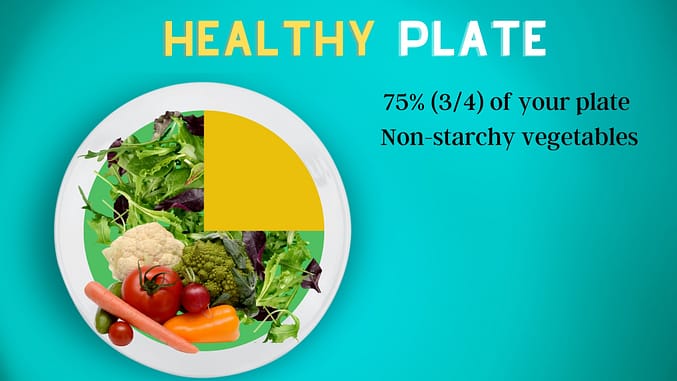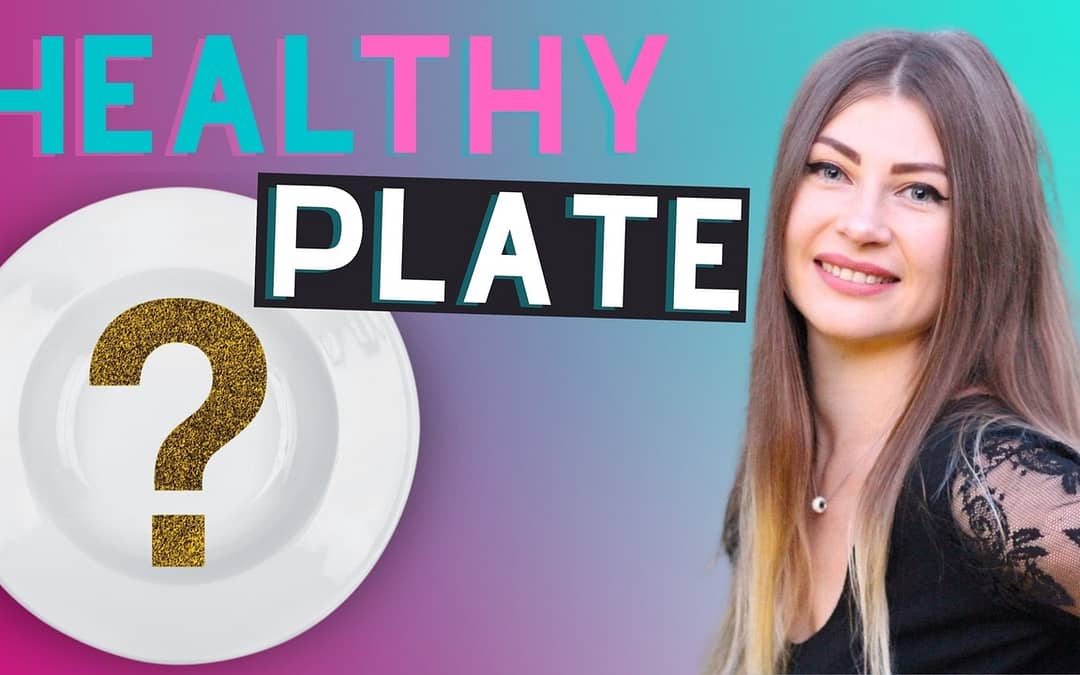In this article, I’m going to show you how to create a healthy plate and share some easy nutrition tips that will make being healthy a lot easier! This way of eating, which I’m going to show you in a minute, is suitable for anyone who’s trying to be healthy. My Healthy Plate is the basis of healthy eating that is suitable for people who are healthy and fit and for people who suffer from various chronic conditions and want to get into better shape. This healthy plate method is suitable for adults, teenagers, and children of all ages, after adjusting the serving sizes of course!
This way of eating will keep your blood glucose and insulin low, provide you with plenty of nutrients to meet your body’s needs, give you more mental clarity, and keep you full and satisfied. If you don’t know who I am, my name is Greta, and I’m an online nutritionist and a health coach. I’ll show you a very simple yet powerful way to fuel your body.
Table of Contents
Start Your Healthy Plate by Filling It Up With Non-Starchy Vegetables.
So first, most of your plate, around 75% by volume should be filled with non-starchy vegetables. Just keep in mind. 75% of volume, not 75% of calories. Non-starchy veggies are very low in calories, so, it wouldn’t keep you full and satisfied if you ate only that. I’ll show you how to create a balanced healthy meal. And you can fill your plate with some raw and some cooked non-starchy veggies. It’s important to have some raw vegetables because cooking can kill certain healthy compounds in plants.

Start Your Healthy Plate by Filling It Up With Non-Starchy Vegetables.
Examples of non-starchy vegetables include veggies such as broccoli, cauliflower, cabbage, bell peppers, zucchini, green beans, tomatoes, cucumbers, spinach, kale, celery, and aubergine. Non-starchy, means they are low in carbohydrates.

How To Create a Healthy Plate? Start by filling it up with non-starchy vegetables.
Why choose non-starchy carbohydrates? Because 90-100% of starchy carbohydrates get broken down into sugar in our bodies. Starch is a lot of glucose molecules bound together. Too much glucose in our diets leads to more insulin, more insulin resistance, weight gain, and increased risk of various chronic diseases such as type 2 diabetes, cancer, heart disease, and dementia.

Healthy Plate: Why choose non-starchy carbohydrates? Because basing your diet on starch (sugar) can have serious health outcomes.
Starchy carbohydrates include bread, rice, all types, white, brown, black rice, and potatoes. These types of carbohydrates should be replaced by non-starchy carbohydrates as they are higher in nutrients and much lower in sugar. Following this simple rule, you will age slower, be leaner, and be able to reduce your risk of chronic diseases.

Healthy Plate: What are Starchy Carbohydrates?
Choose Your Protein Wisely.
Then, coming to the protein sources, choose your protein wisely. Have just enough, not too much, and not too little. Too little protein can lead to muscle atrophy and hair loss. While too much protein can result in faster aging and increased risk of cancer through the activation of the mTor metabolic pathway. Have just the right amount for your body weight and activity level. Also, protein needs are slightly increased for children because they are growing and developing rapidly.
How Much Protein Does An Adult Need?
The Academy of Nutrition and Dietetics recommends that the average individual should consume 0.8 grams of protein per kilogram or 0.35 grams per pound of body weight per day for general health. So a person that weighs 75 kg (165 pounds) should consume an average of 60 grams of protein per day. You would calculate your daily needs like this:
75 x 0.8 = 60g
How Much Protein Does a Child Need a Day?
According to the World Health Organization/Food and Agriculture Organization (WHO/FAO), reference values for protein intake is 0.9 g/kg/day from 3 to 18 years of age for boys and from 3 to 15 years of age for girls. Between 15 and 18 years of age, the level decreases slightly for girls to 0.8 g/kg/day.
And choose a high-quality protein source. I’ll come back to it in a second. When preparing a healthy plate, your protein source should take around ¼ of your plate. You should get around 100g or 3.5oz of meat or fish twice a day. Let’s say you would have 100g with your lunch and 100g with your dinner.

How To Create a Healthy Plate? Choose Your Protein Wisely.
100g or 3.5 ounces of beef would provide you with around 26g of protein per meal. Having this twice a day, you would get 52g of protein, and the rest, needed to meet your daily needs would come from other foods that also contain protein.
When choosing your protein source, make sure your meat is organic grass-fed, and your fish is wild. I don’t recommend farmed animal products because they are full of toxins and they are not healthy. It’s there’s only one food that you can buy organic, it should be your meat. Watch my YouTube video about the Top 11 Foods to Avoid (farmed animal products included on my list). And of course, avoid processed meat such as sausages, at all times because it will increase your risk of cancer.
If you’re a vegetarian or a vegan, you can use the same rules to calculate the amount of protein from foods such as organic tofu, lentils, beans, or other protein sources. I would also say, avoid vegan or vegetarian meat substitutes containing unfermented soy. It can interfere with your hormones and promote cancer growth.

The best vegetarian and vegan plant-based protein sources.
Add Enough Healthy Fat to Your Healthy Plate.
So, 75% of your plate are non-starchy veggies, and around 25% or ¼ of your plate is your protein source. You also need some healthy fat sources. It will help you to absorb fat-soluble vitamins, reduce the insulin spike you would get from foods, provide fuel and materials needed for all the cells in your body, fat is very important for the brain, because fat is the fattiest organ in the human body, with around 60% of it being fat.

When creating a healthy meal, don’t forget to add enough fat. It’s just as important as protein and vegetables.
And also, a very important function of fat is to keep us full and satisfied. Many people find eating plain vegetables difficult, and then avoid vegetables all together. But the key, to making vegetables taste delicious is adding some healthy fat to them. Don’t be afraid to add some grass-fed butter, organic extra virgin coconut oil, or extra virgin olive oil to your salads, or your cooked vegetables. Butter goes really well with broccoli, cauliflower, and cabbage.

Add Enough Healthy Fat to Your Healthy Plate.
And if you are worried about saturated fat and cholesterol clogging up your arteries, you should check out my YouTube video where I talk about Saturated fat, LDL cholesterol, and heart disease risk. Apparently, LDL is a very poor indicator!
What Protein Should You Eat, Lean, or Full-fat?
Also, your protein source does not have to be lean. In fact, lean protein can spike your blood glucose and insulin more. Fat in the protein helps to digest it and reduce this sugar and insulin spike. Just look at this insulin index table, showing how high-fat foods and low-fat foods affect insulin. The higher the percentage, the worse the insulin response.

The Insulin Index Table. How different foods affect your insulin levels.
And as mentioned earlier, high insulin is linked with obesity, cancer, type 2 diabetes, dementia, and many other diseases.
What’s Wrong With Our Dietary Guidelines?
Why should someone use my Healthy Plate method and follow my nutrition tips? Our current dietary guidelines tell us to get most of our calories from starchy carbohydrates, while in fact, our bodies do not require any of these foods. What happens when you follow the food pyramid or the eat well plate/eat well guide? -You end up gaining weight, always feeling hungry and tired, and damaging your health.

What’s Wrong With Our Dietary Guidelines?
Our diets should aim to provide us with all the nutrients that our bodies need to function and keep our blood glucose and insulin at optimal levels (which are quite low). That’s the key to good health. That’s a very easy nutrition tip that can make you have a much longer and healthier life.
Extra Healthy Eating Tip to Enhance Your Healthy Plate.
And, if you feel that you didn’t get enough vitamins, minerals, or antioxidants, maybe you didn’t have enough raw vegetables, because you ate only cooked vegetables, a good way to get more nutrients is having a low-sugar smoothie on the side.
A low-sugar smoothie recipe:
- 1 glass of water,
- 2 handfuls of organic kale or spinach,
- ½ a lemon,
- 12 drops of liquid stevia
- 1 handful of berries such as raspberries, blueberries, blackberries, strawberries, or cranberries.
Mix everything together for 1 minute.

Healthy Low Sugar Smoothie recipe.
Are Fruits Included in The Healthy Eating Plate?
Berries tend to have less sugar than other fruits so try to replace the fruit with berries where possible. If you don’t have any medical conditions such as type 2 diabetes, cancer, fatty liver, insulin resistance, or dementia, and you are not overweight, you could potentially have 1-2 fruits a day, but if you have any of the mentioned conditions, I would recommend avoiding all the fruit except berries.
Here are some of my healthy plate examples. I hope after reading this blog post, you are more confident in making a healthy plate.

A healthy plate example – organic spinach salad with small tomatoes, cucumber, pepper, walnuts, olive oil, and lemon, together with organic pork.

A healthy plate example – organic romaine lettuce, orange bell pepper, olive oil, and lemon, together with organic grass-fed beef. Wild blueberry smoothie.

A healthy plate example – cucumber, tomato, avocado, fresh basil, extra virgin olive oil, lemon, organic pork with turmeric fried in grass-fed butter.
If you want to learn more about healthy eating, you should check out some of my other articles where I explain it in detail. So, this was my detailed explanation of how to create a healthy plate.
If you are trying to lose weight, I invite you to join my online weight loss coaching program, you can join here Online Weight Loss Coaching Program, using the most effective science-based weight loss methods that have nothing to do with eating less and moving more.
Also, you can support Advanced Nutrition and Health with a small donation.

